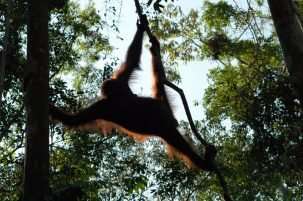Seeing the forest for more than the trees: Adding conservation into holistic development

International development donors and practitioners increasingly recognize that good governance, economic growth, health, and human well-being are inextricably linked—multisectoral programming is the order of the day. But conservation efforts too often get short shrift in the multisectoral paradigm, and too often get left out of the picture. Today, as the world reckons with staggering biodiversity loss, that has to change, and it can.
Historically, projects focused explicitly on biodiversity conservation and watershed management have integrated economic and social development activities as part of their approach: promoting the tourism industry around protected areas, for example, provides an economic incentive for local people to preserve natural assets. Well-designed community-based natural resource management efforts can have a positive impact on people's livelihoods.
But conversely, programs that lead with economic, social, and other development objectives rarely look to embrace conservation, and it's high time we turn the tables—our minds, bodies, and wallets, as well as our planet, will thank us. Conservation can benefit communities in various ways, from enhancing ecosystem services—more attractive tourism destinations, better flood control, cleaner air—to less-tangible cultural and social benefits. People who live near forests are happier than their urban counterparts, to take just one example. Recent work through the Biodiversity Results Improved, Development Gains Enhanced project shows nutritional improvements—in dietary diversity as well as iron and vitamin A consumption—among communities living near intact forests. The initiative has also found a higher incidence of diarrheal disease among children the further downstream they live because watershed disturbances and pollution are greater.
What we are looking for is a condition where conservation and development go hand in hand.
Such evidence suggests that environmental sustainability is a must-have, not a nice-to-have. But experience shows that merely tacking a conservation objective onto traditional development projects doesn't work. Instead, practitioners must explicitly link conservation and development, and demonstrate the costs—human, financial, and environmental—of failing to build conservation into the very marrow of their programs.
But how? For project teams lacking a background in biodiversity conservation or natural resource management, understanding how to integrate conservation into multisectoral programming can be daunting. Here are some suggestions:
- Include environmental sustainability and cost-benefit analysis in the value chain or subsector selection—for example, oil palm plantations might be profitable, but at what cost?
- Use a tool, such as USAID's ecosystems services valuation guidelines, to help economic development or infrastructure planners better understand the costs and benefits of a project.
- Make environmental and social impact evaluation part of organizational capacity assessments to ensure that local partners—ministries of planning, transport, or agriculture, for example—understand the environmental consequences of planned investments.
- Apply a landscape or watershed lens to identify the threats and benefits to human health—for example, work with urban planners to consider reforestation around drinking water sources to lower the cost of water treatment.
- Help public health officials to see environmental management as a sustainable way to improve health and engage environment officials to find areas where they can work together.
By considering these and other options, practitioners can take the first steps toward integrated programming. But we need to be clear about where we want this journey to take us.
Importantly, we are not talking about restricting growth in developing countries or walling off vast tracts as protected areas. The citizens of emerging nations must—and inevitably will—exploit their natural surroundings to make a living from the assets at their disposal. What we are looking for is a condition where conservation and development go hand in hand.
Too often, so-called "multi-use" landscapes are envisaged as "patchworks" of conservation areas and zones of, say, agricultural development. While this metaphor gives an appropriate impression of a shared landscape, our vision should not be based on the notion of a patchwork quilt but rather of a single woven cloth, where the threads of conservation and sustainable development are mutually supportive and mutually dependent. If we can combine conservation, development, and good governance in our program design, we can help rural communities enhance their resilience and well-being. It's time to tie those threads together.
Provided by Earth Institute, Columbia University
This story is republished courtesy of Earth Institute, Columbia University http://blogs.ei.columbia.edu.




















